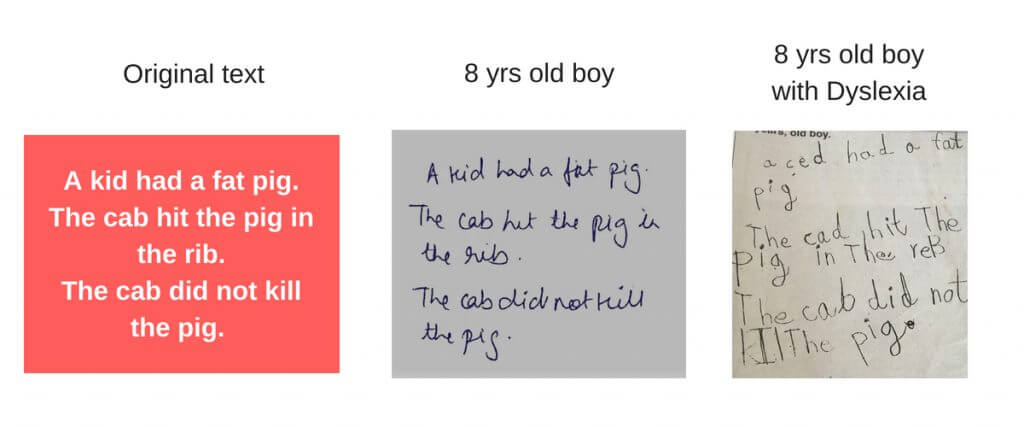 Does your child (6+ yrs)
Does your child (6+ yrs)
- Have particular difficulty with reading and writing?
- Have difficulty in kicking or catching a ball?
- Have difficulty tying shoelaces, tie or while dressing?
- Puts letters and figures the other way around (mirror image/flip) for example, 16 for 61, b’s instead of d’s and n for u?
- Have difficulty in distinguishing between left and right?
- Have difficulty in remembering the order of the days of the week; or months of the year?
- Has a history of delay in speaking, crafting complete sentences or pronouncing words correctly?
- Surprises you because in other areas he/she is bright and alert?
- Has difficulty in remembering tables and alphabets?
 If the answer to all or most of the questions above is YES, then he/she probably needs professional help. Many children have similar difficulties when they are very young but they grow out of them. But if these problems persist over time, even though the child is taught the same as his/her classmates and still falls behind, then it is a cause for concern.
If the answer to all or most of the questions above is YES, then he/she probably needs professional help. Many children have similar difficulties when they are very young but they grow out of them. But if these problems persist over time, even though the child is taught the same as his/her classmates and still falls behind, then it is a cause for concern.
Parents must seek professional help in such cases, as early intervention is crucial and can make a big difference in a child’s continuing learning process. A comprehensive assessment should be made by a multi-disciplinary team of professionals to ascertain whether there is a wide discrepancy between the child’s actual performance and expected performance for their age and class, and whether he/she exhibits recognized dyslexic features or not.
However, adequate thought and care should be given to testing at an early age, because not all learning problems are necessarily learning difficulties. Many children are simply slow in developing certain skills. It might simply be a delay in maturity. To be diagnosed as a “Learning Disability or Learning Difficulty” (LD), a specific criterion must be met.
 LD is a neurological disorder that affects a person’s ability to process the information he/she receives, or to interpret what he/she sees and hears or to link information from different parts of the brain. This limitation can show up in many ways – as specific difficulties that extend to school work and impede the child’s ability as they learn to read (dyslexia), write (dysgraphia) or do math (dyscalculia). One must bear in mind that a learning disability does not include children who have learning problems which are the result of visual, hearing or motor handicaps or mental retardation or emotional disturbance or environmental, cultural or economic disadvantage. The causes of LD may include prenatal, natal, postnatal, genetic, biochemical and psychological factors.
LD is a neurological disorder that affects a person’s ability to process the information he/she receives, or to interpret what he/she sees and hears or to link information from different parts of the brain. This limitation can show up in many ways – as specific difficulties that extend to school work and impede the child’s ability as they learn to read (dyslexia), write (dysgraphia) or do math (dyscalculia). One must bear in mind that a learning disability does not include children who have learning problems which are the result of visual, hearing or motor handicaps or mental retardation or emotional disturbance or environmental, cultural or economic disadvantage. The causes of LD may include prenatal, natal, postnatal, genetic, biochemical and psychological factors.
Dyslexia, which is a language difficulty, has three categories-
- Visual Dyslexia: is marked by reversals of whole word/syllable/letters (b/d, w/m, was/saw, now/won), substitution (house/home), addition of sounds (ischool/school) or omission of letters, syllables, words or word endings (sed for said). It arises due to the child’s short memory span and difficulty in interpreting and recalling visual images.
- Auditory Dyslexia: is characterized by having difficulty in processing and understanding what has been said to him/her. The child cannot distinguish subtle differences in sound (bit/bet, pig/peg) and cannot filter out extraneous sound to the extent that they might get very tense or hyper in a noisy room.
- Deep Dyslexia: is a combination of the above two.

A child with LD might experience a cycle of academic failures and lowered self-esteem. He/she is under constant pressure to perform, both in the class and at home. The child is very sensitive to parental attitude, which often leans towards them feeling guilty and resentful of the fact that their child is dyslexic.
Parents should give their child unconditional support, which would help greatly in their child accepting and coping with their difficulties.Teachers’ attitude must be empathetic and compassionate too.

The school too can play an important role by conducting an awareness programme to sensitize teachers and parents on the problems faced by children with dyslexia. The school should not be rigid about tests and examinations and instead adopt methods to suit individual needs. It should have a policy not to detain a child with dyslexia as far as possible as it is crucial for such children to be with their own age group.
Learning difficulties are slowly being specified and recognized, and support is sought from various boards of examination. At present, ICSE and CBSE boards are giving certain concessions to students with dyslexia who have been identified by the school and assessed by a clinical psychologist and a special educator.
Finally, it is our duty to make a child with learning difficulties realize that the hurdles are in their academic journey alone, and that it is not the end of the road and that his/her other strengths will compensate for these shortcomings.
People like Albert Einstein, Leonardo Da Vinci, Thomas Edison, Christian Anderson and Sir Winston Churchill were people with dyslexia but they overcame their hurdles and achieved fame.
The forthcoming title from Cambridge University Press, Continuing Professional Development by Farida Raj, will be a leap forward in this area of learning and assistance. This book addresses anyone interested in the professional development of teachers – teachers, teacher educators, administrators, education authorities, policy makers and many others.





support teachers should be provided for such children in inclusive education.